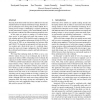Free Online Productivity Tools
i2Speak
i2Symbol
i2OCR
iTex2Img
iWeb2Print
iWeb2Shot
i2Type
iPdf2Split
iPdf2Merge
i2Bopomofo
i2Arabic
i2Style
i2Image
i2PDF
iLatex2Rtf
Sci2ools
EUROSYS
2009
ACM
2009
ACM
Migrating server storage to SSDs: analysis of tradeoffs
Recently, flash-based solid-state drives (SSDs) have become standard options for laptop and desktop storage, but their impact on enterprise server storage has not been studied. Provisioning server storage is challenging. It requires optimizing for the performance, capacity, power and reliability needs of the expected workload, all while minimizing financial costs. In this paper we analyze a number of workload traces from servers in both large and small data centers, to decide whether and how SSDs should be used to support each. We analyze both complete replacement of disks by SSDs, as well as use of SSDs as an intermediate tier between disks and DRAM. We describe an automated tool that, given device models and a block-level trace of a workload, determines the least-cost storage configuration that will support the workload’s performance, capacity, and fault-tolerance requirements. We found that replacing disks by SSDs is not a costeffective option for any of our workloads, due to ...
| Added | 10 Mar 2010 |
| Updated | 10 Mar 2010 |
| Type | Conference |
| Year | 2009 |
| Where | EUROSYS |
| Authors | Dushyanth Narayanan, Eno Thereska, Austin Donnelly, Sameh Elnikety, Antony I. T. Rowstron |
Comments (0)

